欧盟食品添加剂法规04
- 格式:doc
- 大小:76.04 KB
- 文档页数:6
![欧盟添加剂限量标准[整理版]](https://uimg.taocdn.com/a46eff9ca32d7375a41780fc.webp)
欧盟添加剂限量标准[整理版]No L61/1?欧盟议会和理事会指令95/2/EC1995年2月20除了色素和甜味剂的食品添加剂欧盟议会和理事会考虑到欧盟缔结的条约,尤其是第100a条,考虑到委员会的提议,考虑到经济和社会委员会的提议,根据条约第189b制定的程序进行,考虑到1998年12月21理事会指令89/107/EEC,成员国关于为人类消费而在食品中授权使用的食品添加剂的近似法律,尤其是第3(2)条,鉴于国家之间关于防腐剂、抗氧化剂和其它添加剂和它们的使用条件的不同,鉴于这可能造成不公平的竞争。
鉴于主要考虑这些食品添加剂和它们的使用条件应当必须保护消费者的规定,鉴于普遍公认未加工的食品和某些其它食品应当远离食品添加剂,鉴于考虑到最近关于这些物质的科学和毒理学信息,一些仅允许用于某些食品和在某些条件下使用,鉴于必须制定严格的制度在婴儿配方、成长配方及断奶食品中使用食品添加剂,象在1989年3月3日理事会指令89/398/EEC中提到的,有关成员国用于特殊营养使用的食品的相近法律,尤其是第4(1)(e),鉴于本指令不影响涉及甜味剂和色素的规定,鉴于依据1991年7月15日理事会指令91/414/EEC涉及的植物保护产品投放市场,依据1990年11月27日理事会指令90/642/EEC附的在某些植物原始产品中农药残留的最高标准,包括水果和蔬菜,属于此种类的物质暂时包括在本指令中,鉴于向食品科学委员会咨询有关那些物质不是联盟规定的科目,鉴于当决定一个特殊的食品属于食物的某个种类,最好跟随向食品标准委员会咨询的程序,鉴于除色素和甜味剂外的食品添加剂的现存纯标准和那些没有纯标准存在的的新规范的修改将采纳指令89/107/EEC第11条规定的相应程序,鉴于食品科学委员会还没有提出关于面粉处理剂的的建议,鉴于那些试剂将在一个单独的指令中规定,鉴于本指令取代指令64/54/EEC、70/357/EEC、74/329/EEC和83/463/EEC,鉴于那些指令特此废除,兹采纳如下指令:第1条1( 本指令是一个构成综合指令的特定的指令,在89/107/EEC指令的第3条的内涵之内,适用于除色素和甜味剂和面粉处理剂外的添加剂。
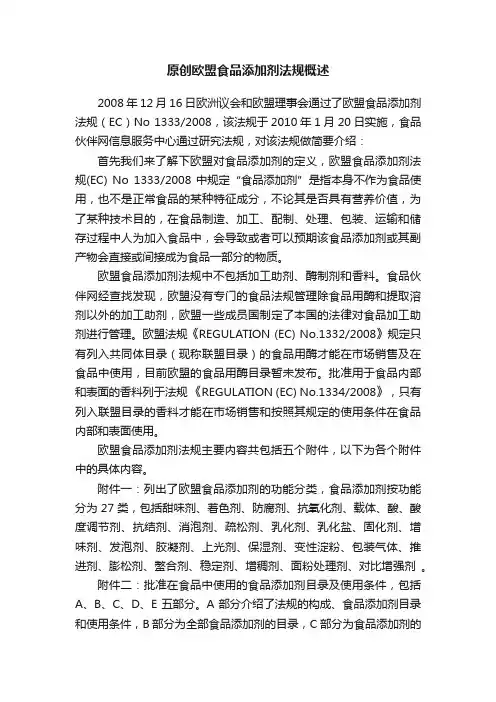
原创欧盟食品添加剂法规概述2008年12月16日欧洲议会和欧盟理事会通过了欧盟食品添加剂法规(EC)No 1333/2008,该法规于2010年1月20日实施,食品伙伴网信息服务中心通过研究法规,对该法规做简要介绍:首先我们来了解下欧盟对食品添加剂的定义,欧盟食品添加剂法规(EC) No 1333/2008中规定“食品添加剂”是指本身不作为食品使用,也不是正常食品的某种特征成分,不论其是否具有营养价值,为了某种技术目的,在食品制造、加工、配制、处理、包装、运输和储存过程中人为加入食品中,会导致或者可以预期该食品添加剂或其副产物会直接或间接成为食品一部分的物质。
欧盟食品添加剂法规中不包括加工助剂、酶制剂和香料。
食品伙伴网经查找发现,欧盟没有专门的食品法规管理除食品用酶和提取溶剂以外的加工助剂,欧盟一些成员国制定了本国的法律对食品加工助剂进行管理。
欧盟法规《REGULATION (EC) No.1332/2008》规定只有列入共同体目录(现称联盟目录)的食品用酶才能在市场销售及在食品中使用,目前欧盟的食品用酶目录暂未发布。
批准用于食品内部和表面的香料列于法规《REGULATION (EC) No.1334/2008》,只有列入联盟目录的香料才能在市场销售和按照其规定的使用条件在食品内部和表面使用。
欧盟食品添加剂法规主要内容共包括五个附件,以下为各个附件中的具体内容。
附件一:列出了欧盟食品添加剂的功能分类,食品添加剂按功能分为27类,包括甜味剂、着色剂、防腐剂、抗氧化剂、载体、酸、酸度调节剂、抗结剂、消泡剂、疏松剂、乳化剂、乳化盐、固化剂、增味剂、发泡剂、胶凝剂、上光剂、保湿剂、变性淀粉、包装气体、推进剂、膨松剂、螯合剂、稳定剂、增稠剂、面粉处理剂、对比增强剂。
附件二:批准在食品中使用的食品添加剂目录及使用条件,包括A、B、C、D、E五部分。
A部分介绍了法规的构成、食品添加剂目录和使用条件,B部分为全部食品添加剂的目录,C部分为食品添加剂的分组定义,D部分为食品分类系统,E部分为批准的食品添加剂在允许使用的食品中的使用条件。
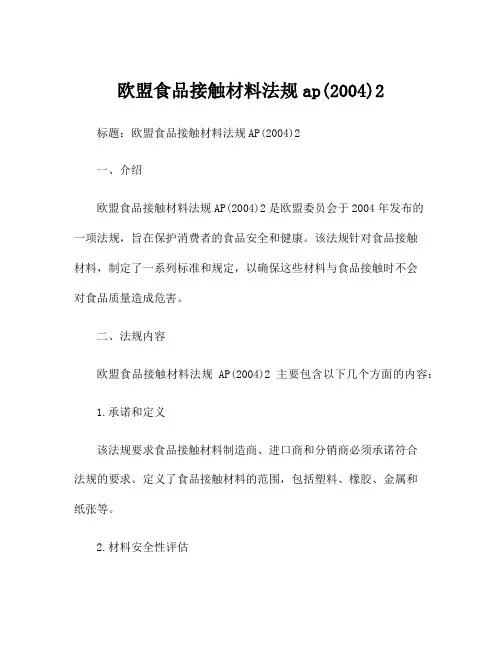
欧盟食品接触材料法规ap(2004)2标题:欧盟食品接触材料法规AP(2004)2一、介绍欧盟食品接触材料法规AP(2004)2是欧盟委员会于2004年发布的一项法规,旨在保护消费者的食品安全和健康。
该法规针对食品接触材料,制定了一系列标准和规定,以确保这些材料与食品接触时不会对食品质量造成危害。
二、法规内容欧盟食品接触材料法规AP(2004)2主要包含以下几个方面的内容:1.承诺和定义该法规要求食品接触材料制造商、进口商和分销商必须承诺符合法规的要求。
定义了食品接触材料的范围,包括塑料、橡胶、金属和纸张等。
2.材料安全性评估该法规要求食品接触材料必须进行安全性评估,以确定其是否对食品安全造成风险。
评估包括物质的迁移和可接受剂量等方面的考虑。
3.限制物质迁移该法规对食品接触材料中的化学物质迁移进行了限制,以确保食品不受到有害物质的污染。
禁止使用一些有害物质,对其他物质的使用进行了限制。
4.标签和包装要求该法规要求食品接触材料必须标明相关信息,如材料成分、使用限制和安全使用指南等。
包装必须保持完整和清洁,以确保食品的卫生安全。
5.检验和监督该法规规定了对食品接触材料进行检验和监督的要求,包括取样和分析等。
违反法规的企业将面临罚款和其他法律责任。
三、实施和影响欧盟食品接触材料法规AP(2004)2于2004年12月生效,并实施到欧盟各成员国。
该法规的实施对食品接触材料生产商和相关行业带来了影响。
1.淘汰有害物质该法规的实施促使企业淘汰使用有害物质的食品接触材料,改用更安全的替代品,从而保护消费者的健康。
2.加强监管和安全性评估该法规的实施加强了监管部门对食品接触材料的监督和检验工作,确保企业的生产符合法规要求。
安全性评估的引入有助于提高食品接触材料的质量,减少食品安全风险。
3.提高消费者信心该法规的实施增强了消费者对食品接触材料安全性的信心,保障了其在购买食品和使用相关产品时的安全和健康。
四、结论欧盟食品接触材料法规AP(2004)2是欧盟为保护消费者食品安全和健康而制定的一项重要法规。
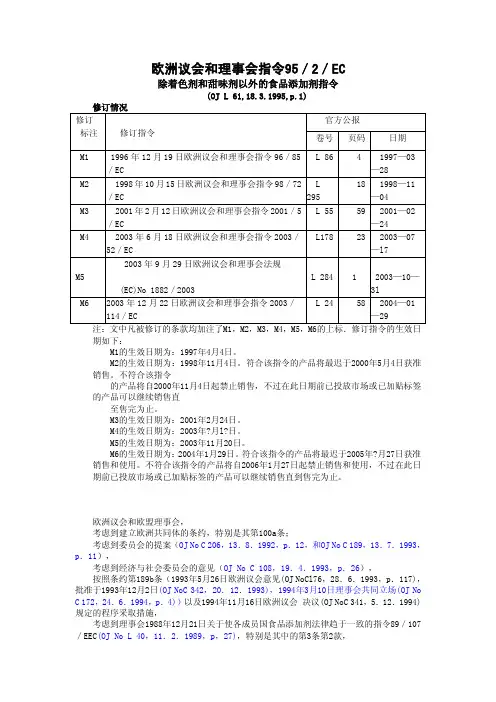
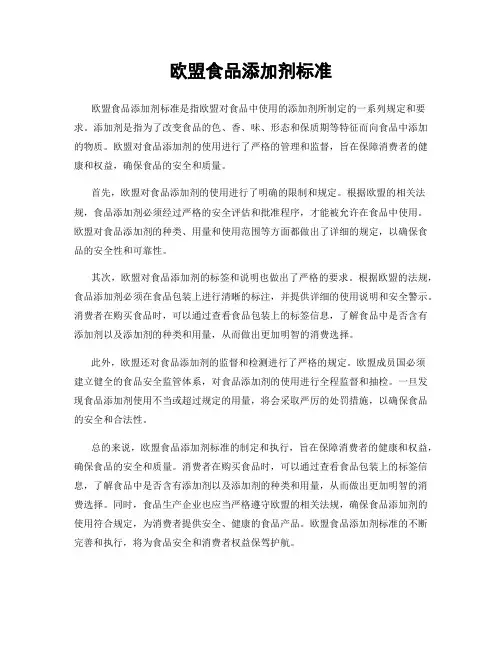
欧盟食品添加剂标准欧盟食品添加剂标准是指欧盟对食品中使用的添加剂所制定的一系列规定和要求。
添加剂是指为了改变食品的色、香、味、形态和保质期等特征而向食品中添加的物质。
欧盟对食品添加剂的使用进行了严格的管理和监督,旨在保障消费者的健康和权益,确保食品的安全和质量。
首先,欧盟对食品添加剂的使用进行了明确的限制和规定。
根据欧盟的相关法规,食品添加剂必须经过严格的安全评估和批准程序,才能被允许在食品中使用。
欧盟对食品添加剂的种类、用量和使用范围等方面都做出了详细的规定,以确保食品的安全性和可靠性。
其次,欧盟对食品添加剂的标签和说明也做出了严格的要求。
根据欧盟的法规,食品添加剂必须在食品包装上进行清晰的标注,并提供详细的使用说明和安全警示。
消费者在购买食品时,可以通过查看食品包装上的标签信息,了解食品中是否含有添加剂以及添加剂的种类和用量,从而做出更加明智的消费选择。
此外,欧盟还对食品添加剂的监督和检测进行了严格的规定。
欧盟成员国必须建立健全的食品安全监管体系,对食品添加剂的使用进行全程监督和抽检。
一旦发现食品添加剂使用不当或超过规定的用量,将会采取严厉的处罚措施,以确保食品的安全和合法性。
总的来说,欧盟食品添加剂标准的制定和执行,旨在保障消费者的健康和权益,确保食品的安全和质量。
消费者在购买食品时,可以通过查看食品包装上的标签信息,了解食品中是否含有添加剂以及添加剂的种类和用量,从而做出更加明智的消费选择。
同时,食品生产企业也应当严格遵守欧盟的相关法规,确保食品添加剂的使用符合规定,为消费者提供安全、健康的食品产品。
欧盟食品添加剂标准的不断完善和执行,将为食品安全和消费者权益保驾护航。
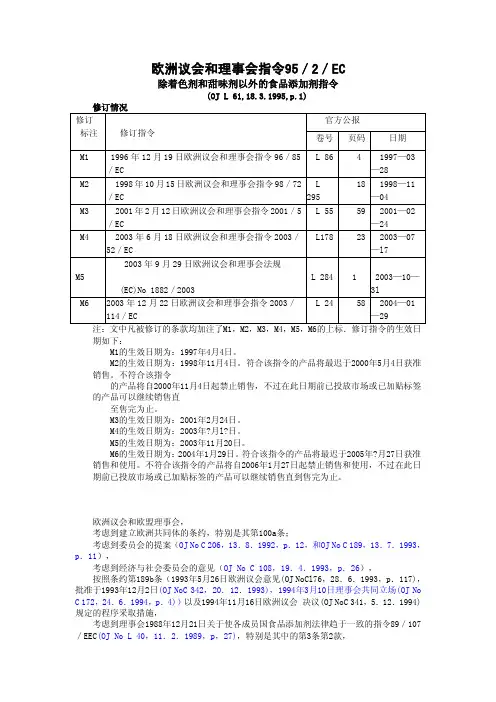
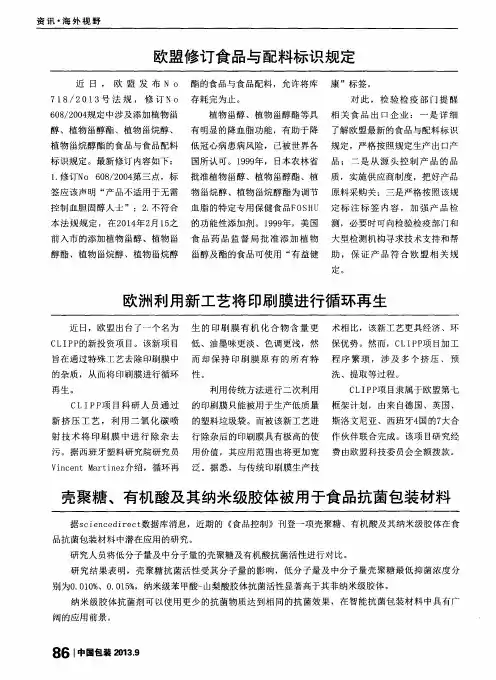
城市园林植物病虫害防治现状和措施师诗(安阳市人民公园管理站,河南安阳455000)摘要:城市园林绿化工程建设是我国城镇化建设发展进程的重要构成,科学开展城市园林植物病虫害防治是改善城市环境、优化绿化城市空间的重要途径。
文章以文献研究法为主要研究方法,对一些城市园林植物病虫害实际状况进行了调查,探讨了城市园林植物病虫害的发生机制以及病虫害防治现状,并尝试探讨了从提高病虫害防治意识与水平、病虫害防治方法、城市园林植物管理人员培训、病虫害长期监测机制的建立等方面提出了城市园林植物病虫害防治的综合性举措,以期为城市园林植物病虫害防治工作的开展提供一定的参考意义。
关键词:城市园林植物;病虫害;防治现状;有效措施中图分类号:S436.8文献标识码:A文章编号:1005-7897(2022)08-0181-030引言随着社会迅猛发展,城市园林植物规模、种类与日俱增,在美化城市环境、减少环境污染等方面发挥着重要的作用。
然而城市园林绿化功能的发挥,离不开城市园林植物养护,尤其是有效的病虫害防治。
从一些城市园林植物病虫害防治开展实践来看,病虫害防治呈现复杂化、危害严重且持久等特征,亟需探索科学预防与控制病虫害的有效举措,文章就此展开论述。
1城市园林植物病虫害特点1.1种类多为提高城市园林景观的观赏性,很多城市园林景观项目都会选用多种植被种类,并购买一些来自其他区域的乔灌木、花卉等。
由于移栽、混种等因素,城市园林植物种类日趋多样,为病虫害提供了多样的寄生、繁衍等环境与营养成分,从而在一定程度上导致寄生病虫种类的增加。
同时,在引用外地植物时,一些园林建设单位没有做好外地植被病虫害检测工作,使得一些外地的病虫随着植被的引入而实现跨区域的传播。
此外,有些园林植物移栽后因生存环境发生变化导致一些病虫害发生个体变异,从而加剧了病虫害防治的多样性。
1.2结构复杂很多城市园林景观项目都会采用混合种植的方式,对乔木、灌木、花卉等园林绿化植物进行搭配,来营造色彩绚丽的生态园林景观。
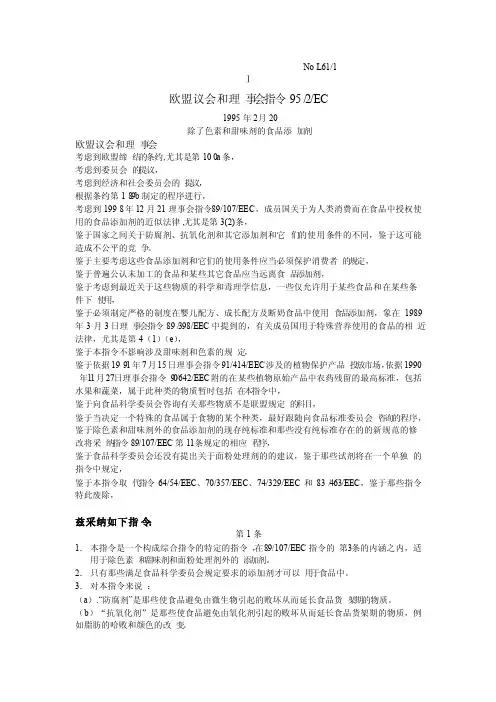
No L61/1Ⅰ欧盟议会和理事会指令95/2/EC1995年2月20除了色素和甜味剂的食品添加剂欧盟议会和理事会考虑到欧盟缔结的条约,尤其是第100a条,考虑到委员会的提议,考虑到经济和社会委员会的提议,根据条约第189b制定的程序进行,考虑到1998年12月21理事会指令89/107/EEC,成员国关于为人类消费而在食品中授权使用的食品添加剂的近似法律,尤其是第3(2)条,鉴于国家之间关于防腐剂、抗氧化剂和其它添加剂和它们的使用条件的不同,鉴于这可能造成不公平的竞争。
鉴于主要考虑这些食品添加剂和它们的使用条件应当必须保护消费者的规定,鉴于普遍公认未加工的食品和某些其它食品应当远离食品添加剂,鉴于考虑到最近关于这些物质的科学和毒理学信息,一些仅允许用于某些食品和在某些条件下使用,鉴于必须制定严格的制度在婴儿配方、成长配方及断奶食品中使用食品添加剂,象在1989年3月3日理事会指令89/398/EEC中提到的,有关成员国用于特殊营养使用的食品的相近法律,尤其是第4(1)(e),鉴于本指令不影响涉及甜味剂和色素的规定,鉴于依据1991年7月15日理事会指令91/414/EEC涉及的植物保护产品投放市场,依据1990年11月27日理事会指令90/642/EEC附的在某些植物原始产品中农药残留的最高标准,包括水果和蔬菜,属于此种类的物质暂时包括在本指令中,鉴于向食品科学委员会咨询有关那些物质不是联盟规定的科目,鉴于当决定一个特殊的食品属于食物的某个种类,最好跟随向食品标准委员会咨询的程序,鉴于除色素和甜味剂外的食品添加剂的现存纯标准和那些没有纯标准存在的的新规范的修改将采纳指令89/107/EEC第11条规定的相应程序,鉴于食品科学委员会还没有提出关于面粉处理剂的的建议,鉴于那些试剂将在一个单独的指令中规定,鉴于本指令取代指令64/54/EEC、70/357/EEC、74/329/EEC和83/463/EEC,鉴于那些指令特此废除,兹采纳如下指令:第1条1.本指令是一个构成综合指令的特定的指令,在89/107/EEC指令的第3条的内涵之内,适用于除色素和甜味剂和面粉处理剂外的添加剂。
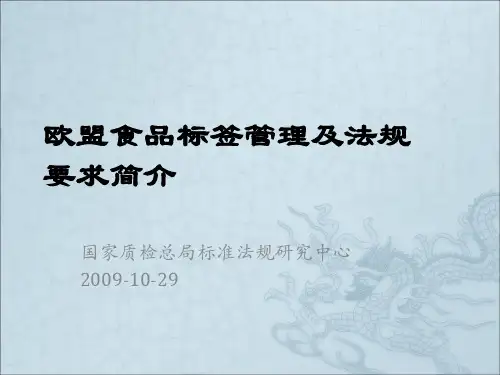
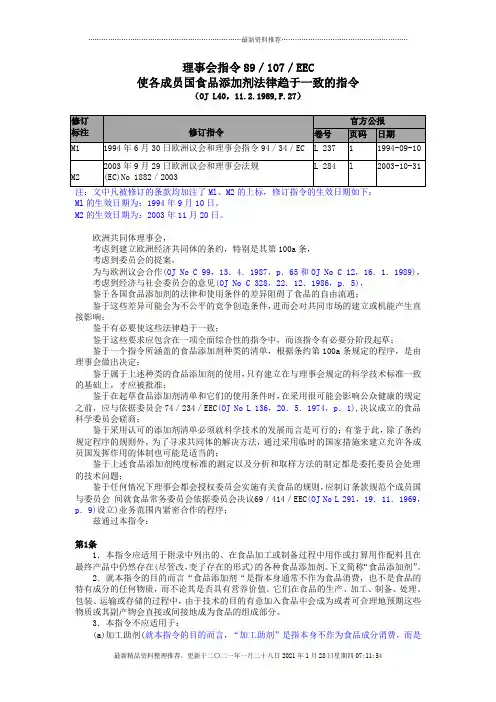
理事会指令89/107/EEC使各成员国食品添加剂法律趋于一致的指令(OJ L40,11.2.1989,P.27)Ml的生效日期为:1994年9月10日。
M2的生效日期为:2003年11月20日。
欧洲共同体理事会,考虑到建立欧洲经济共同体的条约,特别是其第100a条,考虑到委员会的提案,为与欧洲议会合作(OJ No C 99,13.4.1987,p.65和OJ No C 12,16.1.1989),考虑到经济与社会委员会的意见(OJ No C 328,22.12.1986,p.5),鉴于各国食品添加剂的法律和使用条件的差异阻碍了食品的自由流通;鉴于这些差异可能会为不公平的竞争创造条件,进而会对共同市场的建立或机能产生直接影响;鉴于有必要使这些法律趋于一致;鉴于这些要求应包含在一项全面综合性的指令中,而该指令有必要分阶段起草;鉴于一个指令所涵盖的食品添加剂种类的清单,根据条约第100a条规定的程序,是由理事会做出决定;鉴于属于上述种类的食品添加剂的使用,只有建立在与理事会规定的科学技术标准一致的基础上,才应被批准;鉴于在起草食品添加剂清单和它们的使用条件时,在采用很可能会影响公众健康的规定之前,应与依据委员会74/234/EEC(OJ No L 136,20.5.1974,p.1),决议成立的食品科学委员会磋商;鉴于采用认可的添加剂清单必须就科学技术的发展而言是可行的;有鉴于此,除了条约规定程序的规则外,为了寻求共同体的解决方法,通过采用临时的国家措施来建立允许各成员国发挥作用的体制也可能是适当的;鉴于上述食品添加剂纯度标准的测定以及分析和取样方法的制定都是委托委员会处理的技术问题;鉴于任何情况下理事会都会授权委员会实施有关食品的规则,应制订条款规范个成员国与委员会间就食品常务委员会依据委员会决议69/414/EEC(OJ No L 29l,19.11.1969,p.9)设立)业务范围内紧密合作的程序;兹通过本指令:第1条1.本指令应适用于附录中列出的、在食品加工或制备过程中用作或打算用作配料且在最终产品中仍然存在(尽管改,变了存在的形式)的各种食品添加剂。

I(Acts adopted under the EC Treaty/Euratom Treaty whose publication is obligatory)REGULATIONSREGULATION(EC)No1331/2008OF THE EUROPEAN PARLIAMENT AND OF THE COUNCILof16December2008establishing a common authorisation procedure for food additives,food enzymes and food flavourings(Text with EEA relevance)THE EUROPEAN PARLIAMENT AND THE COUNCIL OF THE EURO-PEAN UNION,Having regard to the Treaty establishing the European Commu-nity,and in particular Article95thereof,Having regard to the proposal from the Commission,Having regard to the opinion of the European Economic and Social Committee(1),Acting in accordance with the procedure laid down in Article251 of the Treaty(2),Whereas:(1)The free movement of safe and wholesome food is anessential aspect of the internal market and contributes sig-nificantly to the health and well-being of citizens,and totheir social and economic interests.(2)A high level of protection of human life and health shouldbe assured in the pursuit of Community policies.(3)In order to protect human health,the safety of additives,enzymes and flavourings for use in foodstuffs for humanconsumption must be assessed before they are placed onthe Community market.(4)Regulation(EC)No1333/2008of the European Parlia-ment and of the Council of16December2008on foodadditives(3),Regulation(EC)No1332/2008of the Euro-pean Parliament and of the Council of16December2008on food enzymes(4)and Regulation(EC)No1334/2008of the European Parliament and of the Council of16December2008on flavourings and certain food ingre-dients with flavouring properties for use in and on foods(5)(hereinafter referred to as the sectoral food laws)lay downharmonised criteria and requirements concerning theassessment and authorisation of these substances.(5)It is envisaged,in particular,that food additives,foodenzymes and food flavourings,to the extent that the safetyof food flavourings must be assessed in accordance withRegulation(EC)No1334/2008[on flavourings and certainfood ingredients with flavouring properties for use in andon foods],must not be placed on the market or used infoodstuffs for human consumption,in accordance with theconditions laid down in each sectoral food law,unless theyare included on a Community list of authorised substances.(6)Ensuring transparency in the production and handling offood is absolutely crucial in order to maintain consumerconfidence.(7)In this context,it appears appropriate to establish for thesethree categories of substances a common Communityassessment and authorisation procedure that is effective,time-limited and transparent,so as to facilitate their freemovement within the Community market.(1)OJ C168,20.7.2007,p.34.(2)Opinion of the European Parliament of10July2007(OJ C175E,10.7.2008,p.134),Council Common Position of10March2008 (OJ C111E,6.5.2008,p.1),Position of the European Parliament of 8July2008(not yet published in the Official Journal)and Council Decision of18November2008.(3)See page16of this Official Journal.(4)See page7of this Official Journal.(5)See page34of this Official Journal.(8)This common procedure must be founded on the prin-ciples of good administration and legal certainty and mustbe implemented in compliance with those principles.(9)This Regulation will thus complete the regulatory frame-work concerning the authorisation of the substances bylaying down the various stages of the procedure,the dead-lines for those stages,the role of the parties involved andthe principles that apply.Nevertheless,for some aspects ofthe procedure,it is necessary to take the specific character-istics of each sectoral food law into consideration.(10)The deadlines laid down in the procedure take into accountthe time needed to consider the different criteria set in eachsectoral food law,as well as allowing adequate time forconsultation when preparing the draft measures.In par-ticular,the nine-months deadline for the Commission topresent a draft regulation updating the Community listshould not preclude the possibility of this being donewithin a shorter period.(11)Upon receipt of an application the Commission should ini-tiate the procedure and where necessary seek the opinionof the European Food Safety Authority(hereinafter referredto as the Authority)established by Regulation(EC)No178/2002of the European Parliament and of the Coun-cil of28January2002laying down the general principlesand requirements of food law,establishing the EuropeanFood Safety Authority and laying down procedures in mat-ters of food safety(1)as soon as possible after the validityand applicability of the application have been assessed.(12)In accordance with the framework for risk assessment inmatters of food safety established by Regulation(EC)No178/2002,the authorisation to place substances on themarket must be preceded by an independent scientificassessment,of the highest possible standard,of the risksthat they pose to human health.This assessment,whichmust be carried out under the responsibility of the Author-ity,must be followed by a risk management decision takenby the Commission under a regulatory procedure thatensures close cooperation between the Commission andthe Member States.(13)The authorisation to place substances on the market shouldbe granted pursuant to this Regulation provided that thecriteria for authorisation laid down under the sectoral foodlaws are satisfied.(14)It is recognised that,in some cases,scientific risk assess-ment alone cannot provide all the information on which arisk management decision should be based,and that otherlegitimate factors relevant to the matter under consider-ation may be taken into account,including societal,eco-nomic,traditional,ethical and environmental factors andthe feasibility of controls.(15)In order to ensure that both business operators in the sec-tors concerned and the public are kept informed of theauthorisations in force,the authorised substances shouldbe included on a Community list created,maintained andpublished by the Commission.(16)Where appropriate and under certain circumstances,thespecific sectoral food law may provide for protection ofscientific data and other information submitted by theapplicant for a certain period of time.In this case,the sec-toral food law should lay down the conditions under whichthese data may not be used for the benefit of anotherapplicant.(17)Networking between the Authority and the Member States’organisations operating in the fields within the Authority’smission is one of the basic principles of the Authority’soperation.In consequence,in preparing its opinion,theAuthority may use the network made available to it byArticle36of Regulation(EC)No178/2002and by Com-mission Regulation(EC)No2230/2004(2).(18)The common authorisation procedure for the substancesmust fulfil transparency and public information require-ments while guaranteeing the right of applicants to pre-serve the confidentiality of certain information.(19)Protecting the confidentiality of certain aspects of an appli-cation should be maintained as a consideration in order toprotect the competitive position of an applicant.However,information relating to the safety of a substance,includ-ing,but not limited to,toxicological studies,other safetystudies and raw data as such,should under no circum-stances be confidential.(20)Pursuant to Regulation(EC)No178/2002,Regulation(EC)No1049/2001of the European Parliament and of theCouncil of30May2001regarding public access to Euro-pean Parliament,Council and Commission documents(3)applies to documents held by the Authority.(1)OJ L31,1.2.2002,p.1.(2)Regulation(EC)No2230/2004of23December2004laying downdetailed rules for the implementation of European Parliament and Council Regulation(EC)No178/2002with regard to the network of organisations operating in the fields within the European Food Safety Authority’s mission(OJ L379,24.12.2004,p.64).(3)OJ L145,31.5.2001,p.43.(21)Regulation(EC)No178/2002establishes procedures fortaking emergency measures in relation to foodstuffs ofCommunity origin or imported from third countries.Itauthorises the Commission to adopt such measures in situ-ations where foodstuffs are likely to constitute a seriousrisk to human health,animal health or the environmentand where such risk cannot be contained satisfactorily bymeasures taken by the Member State(s)concerned.(22)In the interests of efficiency and legislative simplification,there should be a medium-term examination of the ques-tion whether to extend the scope of the common proce-dure to other legislation in the area of food.(23)Since the objectives of this Regulation cannot be suffi-ciently achieved by the Member States on account of dif-ferences between national laws and provisions and cantherefore be better achieved at Community level,the Com-munity may adopt measures,in accordance with the prin-ciple of subsidiarity as set out in Article5of the Treaty.Inaccordance with the principle of proportionality,as set outin that Article,this Regulation does not go beyond what isnecessary in order to achieve those objectives.(24)The measures necessary for the implementation of thisRegulation should be adopted in accordance with CouncilDecision1999/468/EC of28June1999laying down theprocedures for the exercise of implementing powers con-ferred on the Commission(1).(25)In particular the Commission should be empowered toupdate the Community lists.Since those measures are ofgeneral scope and are designed to amend non-essential ele-ments of each sectoral food law,inter alia,by supplement-ing it with new non-essential elements,they must beadopted in accordance with the regulatory procedurewith scrutiny provided for in Article5a of Decision1999/468/EC.(26)On grounds of efficiency,the normal time-limits for theregulatory procedure with scrutiny should be curtailed forthe addition of substances to the Community lists and foradding,removing or changing conditions,specifications orrestrictions associated with the presence of a substance onthe Community lists.(27)When,on imperative grounds of urgency,the normal time-limits for the regulatory procedure with scrutiny cannot becomplied with,the Commission should be able to applythe urgency procedure provided for in Article5a(6)ofDecision1999/468/EC for the removal of a substancefrom the Community lists and for adding,removing orchanging conditions,specifications or restrictions associ-ated with the presence of a substance on the Communitylists,HAVE ADOPTED THIS REGULATION:CHAPTER IGENERAL PRINCIPLESArticle1Subject matter and scope1.This Regulation lays down a common procedure for the assessment and authorisation(hereinafter referred to as the com-mon procedure)of food additives,food enzymes,food flavour-ings and source materials of food flavourings and of food ingredients with flavouring properties used or intended for use in or on foodstuffs(hereinafter referred to as the substances),which contributes to the free movement of food within the Community and to a high level of protection of human health and to a high level of consumer protection,including the protection of con-sumer interests.This Regulation shall not apply to smoke flavour-ings falling within the scope of Regulation(EC)No2065/2003of the European Parliament and of the Council of10November 2003on smoke flavourings used or intended for use in or on foods(2).2.The common procedure shall lay down the procedural arrangements for updating the lists of substances the marketing of which is authorised in the Community pursuant to Regulation (EC)No1333/2008[on food additives],Regulation(EC) No1332/2008[on food enzymes]and Regulation(EC) No1334/2008[on flavourings and certain food ingredients with flavouring properties for use in and on foods](hereinafter referred to as the sectoral food laws).3.The criteria according to which substances can be included on the Community list provided for in Article2,the content of the regulation referred to in Article7and,where applicable,the transitional provisions concerning ongoing procedures are laid down in each sectoral food law.Article2Community list of substances1.Under each sectoral food law,substances that have been authorised to be placed on the Community market shall be included on a list the content of which is determined by the said law(hereinafter referred to as the Community list).The Commu-nity list shall be updated by the Commission.It shall be published in the Official Journal of the European Union.2.‘Updating the Community list’means:(a)adding a substance to the Community list;(1)OJ L184,17.7.1999,p.23.(2)OJ L309,26.11.2003,p.1.(b)removing a substance from the Community list;(c)adding,removing or changing conditions,specifications orrestrictions associated with the presence of a substance on the Community list.CHAPTER IICOMMON PROCEDUREArticle3Main stages of the common procedure1.The common procedure for updating the Community list may be started either on the initiative of the Commission or fol-lowing an application.Applications may be made by a Member State or by an interested party,who may represent several inter-ested parties,in accordance with the conditions provided for by the implementing measures referred to in Article9(1)(a)(herein-after referred to as the applicant).Applications shall be sent to the Commission.2.The Commission shall seek the opinion of the European Food Safety Authority(hereinafter referred to as the Authority),to be given in accordance with Article5.However,for the updates referred to in Article2(2)(b)and(c),the Commission shall not be required to seek the opinion of the Authority if the updates in question are not liable to have an effect on human health.3.The common procedure shall end with the adoption by the Commission of a regulation implementing the update,in accor-dance with Article7.4.By way of derogation from paragraph3,the Commission may end the common procedure and decide not to proceed with a planned update,at any stage of the procedure,if it judges that such an update is not justified.Where applicable,it shall take account of the opinion of the Authority,the views of Member States,any relevant provisions of Community law and any other legitimate factors relevant to the matter under consideration.In such cases,where applicable,the Commission shall inform the applicant and the Member States directly,indicating in its letter the reasons for not considering the update justified.Article4Initiating the procedure1.On receipt of an application to update the Community list, the Commission:(a)shall acknowledge receipt of the application in writing to theapplicant within14working days of receiving it;(b)where applicable,shall as soon as possible notify the Author-ity of the application and request its opinion in accordance with Article3(2).The application shall be made available to the Member States by the Commission.2.Where it starts the procedure on its own initiative,the Com-mission shall inform the Member States and,where applicable, request the opinion of the Authority.Article5Opinion of the Authority1.The Authority shall give its opinion within nine months of receipt of a valid application.2.The Authority shall forward its opinion to the Commission, the Member States and,where applicable,the applicant.Article6Additional information concerning risk assessment1.In duly justified cases where the Authority requests addi-tional information from applicants,the period referred to in Article5(1)may be extended.After consulting the applicant,the Authority shall lay down a period within which this information can be provided and shall inform the Commission of the addi-tional period needed.If the Commission does not object within eight working days of being informed by the Authority,the period referred to in Article5(1)shall be automatically extended by the additional period.The Commission shall inform the Member States of the extension.2.If the additional information is not sent to the Authority within the additional period referred to in paragraph1,the Authority shall finalise its opinion on the basis of the informa-tion already provided.3.Where applicants submit additional information on their own initiative,they shall send it to the Authority and to the Com-mission.In such cases,the Authority shall give its opinion within the original period without prejudice to Article10.4.The additional information shall be made available to the Member States and the Commission by the Authority.Article7Updating the Community list1.Within nine months of the Authority giving its opinion,the Commission shall submit to the Committee referred to in Article14(1)a draft regulation updating the Community list,tak-ing account of the opinion of the Authority,any relevant provi-sions of Community law and any other legitimate factors relevant to the matter under consideration.In those cases where an opinion of the Authority has not been requested,the nine-month period shall start from the date the Commission receives a valid application.2.In the Regulation updating the Community list,the consid-erations on which it is based shall be explained.3.Where the draft regulation is not in accordance with the opinion of the Authority,the Commission shall explain the rea-sons for its decision.4.The measures,designed to amend non-essential elements of each sectoral food law,relating to the removal of a substance from the Community list,shall be adopted in accordance with the regulatory procedure with scrutiny referred to in Article14(3).5.On grounds of efficiency,the measures designed to amend non-essential elements of each sectoral food law,inter alia,by supplementing it,relating to the addition of a substance to the Community list and for adding,removing or changing conditions, specifications or restrictions associated with the presence of the substance on the Community list,shall be adopted in accordance with the regulatory procedure with scrutiny referred to in Article14(4).6.On imperative grounds of urgency,the Commission may use the urgency procedure referred to in Article14(5)for the removal of a substance from the Community list and for adding, removing or changing conditions,specifications or restrictions associated with the presence of a substance on the Community list.Article8Additional information concerning risk management1.Where the Commission requests additional information from applicants on matters concerning risk management,it shall determine,together with the applicant,a period within which that information can be provided.In such cases,the period referred to in Article7may be extended accordingly.The Commission shall inform the Member States of the extension and shall make the additional information available to the Member States once it has been provided.2.If the additional information is not sent within the addi-tional period referred to in paragraph1,the Commission shall act on the basis of the information already provided.CHAPTER IIIMISCELLANEOUS PROVISIONSArticle9Implementing measures1.In accordance with the regulatory procedure referred to in Article14(2),within a period of no longer than24months from the adoption of each sectoral food law,the implementing mea-sures for this Regulation shall be adopted by the Commission,and shall concern in particular:(a)the content,drafting and presentation of the applicationreferred to in Article4(1);(b)the arrangements for checking the validity of applications;(c)the type of information that must be included in the opinionof the Authority referred to in Article5.2.With a view to the adoption of the implementing measures referred to in paragraph1(a),the Commission shall consult the Authority,which,within six months of the date of entry into force of each sectoral food law,shall present it with a proposal concerning the data required for risk assessment of the substances concerned.Article10Extension of time periodsIn exceptional circumstances,the periods referred to in Article5(1)and Article7may be extended by the Commission on its own initiative or,where applicable,at the Authority’s request, if the nature of the matter in question so justifies,without preju-dice to Article6(1)and Article8(1).In such cases the Commis-sion shall,where appropriate,inform the applicant and the Member States of the extension and the reasons for it.Article11TransparencyThe Authority shall ensure the transparency of its activities in accordance with Article38of Regulation(EC)No178/2002.In particular,it shall make its opinions public without delay.It shall also make public any request for its opinion as well as any exten-sion of period pursuant to Article6(1).Article12Confidentiality1.Among the information provided by applicants,confiden-tial treatment may be given to information the disclosure of which might significantly harm their competitive position.Information relating to the following shall not,in any circum-stances,be regarded as confidential:(a)the name and address of the applicant;(b)the name and a clear description of the substance;(c)the justification for the use of the substance in or on specificfoodstuffs or food categories;(d)information that is relevant to the assessment of the safety ofthe substance;(e)where applicable,the analysis method(s).2.For the purposes of implementing paragraph1,applicants shall indicate which of the information provided they wish to be treated as confidential.Verifiable justification must be given in such cases.3.The Commission shall decide after consulting with the applicants which information can remain confidential and shall notify applicants and the Member States accordingly.4.After being made aware of the Commission’s position, applicants shall have three weeks in which to withdraw their application so as to preserve the confidentiality of the informa-tion provided.Confidentiality shall be preserved until this period expires.5.The Commission,the Authority and the Member States shall,in accordance with Regulation(EC)No1049/2001,take the necessary measures to ensure appropriate confidentiality of the information received by them under this Regulation,except for information which must be made public if circumstances so require in order to protect human health,animal health or the environment.6.If an applicant withdraws,or has withdrawn,its application, the Commission,the Authority and the Member States shall not disclose confidential information,including information the con-fidentiality of which is the subject of disagreement between the Commission and the applicant.7.The implementation of paragraphs1to6shall not affect the circulation of information between the Commission,the Authority and the Member States.Article13EmergenciesIn the event of an emergency concerning a substance on the Com-munity list,particularly in the light of an opinion of the Author-ity,measures shall be adopted in accordance with the procedures referred to in Articles53and54of Regulation(EC)No178/2002.Article14Committee1.The Commission shall be assisted by the Standing Commit-tee on the Food Chain and Animal Health established by Article58 of Regulation(EC)No178/2002.2.Where reference is made to this paragraph,Articles5and7 of Decision1999/468/EC shall apply,having regard to the pro-visions of Article8thereof.The period laid down in Article5(6)of Decision1999/468/EC shall be set at three months.3.Where reference is made to this paragraph,Article5a(1) to(4)and Article7of Decision1999/468/EC shall apply,having regard to the provisions of Article8thereof.4.Where reference is made to this paragraph,Article5a(1) to(4)and(5)(b)and Article7of Decision1999/468/EC shall apply,having regard to the provisions of Article8thereof.The time-limits laid down in Article5a(3)(c)and(4)(b)and(e)of Decision1999/468/EC shall be two months,two months and four months respectively.5.Where reference is made to this paragraph,Article5a(1),(2), (4)and(6)and Article7of Decision1999/468/EC shall apply, having regard to the provisions of Article8thereof.Article15Competent authorities of the Member StatesNot later than six months after the entry into force of each sec-toral food law,Member States shall forward to the Commission and to the Authority,in relation to each sectoral food law,the name and address of the national competent authority for the purposes of the common procedure,as well as a contact point therein.CHAPTER IVFINAL PROVISIONArticle16Entry into forceThis Regulation shall enter into force on the20th day following its publication in the Official Journal of the European Union.For each sectoral food law,it shall apply from the date of appli-cation of the measures referred to in Article9(1).Article9shall apply from20January2009.This Regulation shall be binding in its entirety and directly applicable in all Member States. Done at Strasbourg,16December2008.For the European ParliamentThe PresidentH.-G.PÖTTERING For the Council The President B.LE MAIRE。
欧盟允许使用的食品添加剂对物质进行分类是一个比较复杂的过程,食品添加剂的分类也不例外,欧盟是从使用功能上对添加剂进行分类的。
从功能方面对食品添加剂进行分类是一种比较好的方法,由于添加剂的功能取决于其加入量的多少,所以它与摄入量是有密切联系的,在评价消费者可能的摄入量时,功能以及添加剂量是需要考虑的两个重要方面。
欧洲委员会的立法对食品添加剂有以下3个粗略的分类:(1)甜味剂(94/35/EC法令);(2)着色剂(94/36/EC法令);(3)除甜味剂和着色剂以外的添加剂(95/2/EC法令)——“多种”添加剂法令。
欧盟的食品添加剂分类及定义见下表:欧盟添加剂种类定义酸增加食物酸度的物质以及赋予食物酸味的物质酸度调节剂调节和控制食物酸碱性的物质抗结剂能减少食物颗粒黏附到一起的物质消泡剂能阻止或减少泡沫形成的物质膨松剂能增加食品的体积,而对其能量值没有明显影响的物质载体以及载体溶剂用于溶解、稀释食物或用其他物理手段以改变食物状态的添加剂,以方便操作、应用或使用着色剂增加或恢复食物颜色的物质,包括食物的天然成分和天然来源的物质,这些物质不能作为食物来消费,也不能作为食物的特征成分乳化剂将两种或两种以上互不相容的物质如食物中的油和水形成均匀混合物或能维持混合物均匀状态的物质乳化盐将乳酪中的蛋白质转化为分散的形式,从而使脂肪和其他成分呈均匀分布状态的物质固定剂使水果和蔬菜组织保持新鲜状态的物质或者可与凝胶剂作用形成和增强凝胶的物质增味剂增强食物原有口味或/和风味的物质面粉处理剂(FTA) 添加到面粉和面团,改善面团烘焙质量的物质(与乳化剂不同)上光剂涂抹到食物外表面后,可赋予食物光泽外观或能给食物提供保护层的物质水分保持剂能防止食物在低湿度的空气中变干的物质,或促进粉状物在水溶液中溶解的物质改性淀粉将食用淀粉进行一种或多种化学处理,如物理处理、酶处理、酸处理或碱处理后得到的物质填充气体除了空气以外的,在将食物放入容器前、放入时或放入后充入到容器中的气体推进气体除了空气以外的,将食物从容器中排出的气体发泡剂本身或混合后可释放出气体,从而增大生面团或面糊体积的物质发泡剂本身或混合后可释放出气体,从而增大生面团或面糊体积的物质螯合剂可与金属离子形成化合物的物质稳定剂能维持食物物理状态的物质,能使食物中两种或两种以上互不相容的物质呈均匀分散状态的物质,能使食物已有色泽保持稳定的物质甜味剂能赋予食物甜味的物质增稠剂能增加食物黏度的物质欧盟食品添加剂列表酸编码添加剂名称270 乳酸296 苹果酸2330 柠檬酸334 酒石酸338 磷酸353 偏酒石酸355 己二酸363 琥珀酸507 盐酸513 硫酸574 葡萄糖575 葡糖酸一δ一内醋酸度调节剂编码添加剂名称327 乳酸钙331 柠檬酸钠:(1)柠檬酸一钠;(2)柠檬酸二钠;(3)柠檬酸三钠332 柠檬酸钾:(1)柠檬酸一钾;(2)柠檬酸三钾333 柠檬酸钙:(1)柠檬酸一钙;(2)柠檬酸二钙;(3)柠檬酸三钙339 磷酸钠:(1)磷酸一钠;(2)磷酸二钠;(3)磷酸三钠340 磷酸钾:(1)磷酸一钾;(2)磷酸二钾;(3)磷酸三钾341 磷酸钙:(1)磷酸一钙;(2)磷酸二钙;(3)磷酸三钙343 磷酸镁:(1)磷酸一镁;(2)磷酸二镁350 苹果酸钠:(1)苹果酸钠;(2)苹果酸氢钠351 苹果酸钾352 苹果酸钙:(1)苹果酸钙;(2)苹果酸氢钙354 酒石酸钙356 己二酸钠357 己二酸钾380 柠檬酸三铵450 二磷酸二钙500 碳酸钠:(1)碳酸钠;(3)碳酸氢三钠501 碳酸钾:(1)碳酸钾;(2)碳酸氢钾503 碳酸铵:(1)碳酸铵;(2)碳酸氢铵504 碳酸镁:(1)碳酸镁;(2)碳酸氢镁514 硫酸氢钠515 磷酸氢钾522 硫酸钾铝523 硫酸饺铝524 氢氧化钠525 氢氧化钾526 氢氯化钙527 氢氧化铵528 氢氧化镁529 氧化钙577 葡糖酸钾3抗结剂编码添加剂名称530 氧化镁535 亚铁氰化钠536 亚铁氰化钾538 亚铁氰化钙551 二氧化硅552 硅酸钙553 硅酸镁:a(1)硅酸镁;(2)1硅酸镁(合成) 、2三硅酸镁b 滑石粉554 硅酸铝钠555 硅酸铝钾556 硅酸铝钙558 膨润土559 硅酸铝(高岭土)消泡剂编码添加剂名称900 甲基聚硅氧烷1521 聚乙二醇6000膨松剂编码添加剂名称1200 聚糊精着色剂编码添加剂名称100 姜黄素101 核黄素:(1)核黄素;(2)核黄素-5’-磷酸102 柠檬黄104 喹啉黄110 日落黄;柑橘黄120 胭脂虫红,胭脂红酸,洋红122 偶氮玉红,酸性红123 苋菜红124 胭脂红,洋红A127 赤藓红128 红色2G129 诱惑红131 专利蓝V132 靛蓝133 亮蓝140 叶绿素和叶绿酸:(1)叶绿素;(2)叶绿酸141 叶绿素和叶绿酸的铜盐:(1)叶绿素铜盐;(2)叶绿酸铜盐142 绿色S150 焦糖色:a 不加氨生产;b 苛性亚硫酸法;c加氨生产;d 亚硫酸铵法151 亮黑.黑色PN153 植物炭4154 棕色FK155 棕色HT160 胡萝卜素:a 胡萝卜素(1)复合胡萝卜素;(2)β-胡萝卜素b 胭脂橙红,胭脂树橙,降胭脂树橙c 红辣椒提取物,辣椒红素,辣椒玉红素d 番茄红素e β-阿朴-8’-胡萝卜醛(C30)f β-阿朴-8’-胡萝卜酸(C30)乙酯161 b 叶黄素;g 斑蝥黄质162 甜菜红,甜菜苷163 花青素苷类170 碳酸钙171 二氧化钛172 铁的氧化物和氢氧化物173 铝174 银175 金180 立素玉红BK(Litholrubine BK)乳化剂编码添加剂名称322 卵磷脂431 聚氧乙烯硬脂酸酯432 聚氧乙烯山梨醇酐433 聚氧乙烯山梨醇酐油酸酯434 聚氧乙烯山梨醇酐单棕榈酸酯435 聚氯乙烯山梨醇酐单硬脂酸酯436 聚氧乙烯山梨醇酐三硬脂酸酯442 磷脂酸铵444 酸异丁酸葡糖酯445 木松香甘油酯460 纤维素:(1)微晶纤维素;(2)粉状纤维素470 a 脂肪酸钠、钾、盐;b 脂肪酸镁盐471 脂肪酸单、双甘油酯472 脂肪酸单、双甘油酸酯:a 脂肪酸单、双甘油乙酸酯b 脂肪酸单、双甘油乳酸酯c 脂肪酸单、双甘油柠檬酸酯d 脂肪酸单、双甘油酒石酸酯e 脂肪酸单、双甘油单、双乙酰化酒石酸酯f 脂肪酸单、双甘油混合乙酸和酒石酸酯481 硬脂酰乳酸钠482 硬脂酰乳酸钙491 单硬脂酸山梨醇酐酯492 三硬脂酸山梨醇酐酯493 单月桂酸山梨醇酐酯494 单油酸山梨醇酐酯5495 单棕榈酸山梨醇酐酯473 蔗糖脂肪酸酯474 蔗糖甘油酯475 脂肪酸聚甘油酯476 聚甘油聚蓖麻醇酸酯477 脂肪酸丙二醇单、双酯479 b 热氧化大豆油与脂肪酸单、双甘油酯的交联物乳化盐编码添加剂名称450 二磷酸盐:(2)二磷酸三钠;(3)二磷酸四钠;(5)二磷酸四钾(7)二磷酸二氢酐452 聚磷酸盐:(1)2聚磷酸钠(不溶);(2)聚磷酸钾;(3)聚磷酸钠钙;(4)聚磷酸钙固定剂编码添加剂名称520 硫酸铝521 硫酸钠铝增味剂编码添加剂名称515 (1)硫酸钾620 谷氨酸621 谷氨酸一钠622 谷氨酸一钾623 谷氨酸钙624 谷氨酸一铵625 谷氨酸镁626 鸟苷酸627 鸟苷酸二钠628 鸟苷酸二钾629 鸟苷酸钙630 肌酐酸631 鸟苷酸二钠632 鸟苷酸二钾633 鸟苷酸钙634 5’一核糖核苷酸钙635 5’一核糖核苷酸二钠640 甘氨酸及其钠盐面粉处理剂编码添加剂名称483 硬脂酰酒石酸酯517 硫酸铵541 酸性磷酸铝钠920 L一半胱氨酸927 b 尿素516 硫酸钙抛光剂6编码添加剂名称469 酶水解的羧甲基纤维素904 虫胶905 结晶石蜡901 蜂蜡,白色和黄色902 小烛树蜡903 巴西棕榈蜡水分保持剂编码添加剂名称422 甘油1518 三乙酸甘油酯(甘油三乙酸酯)1520 丙烷一1,2—二元醇填充气体编码添加剂名称938 氩939 氦948 氧推进气体编码添加剂名称290 二氧化碳941 氮942 一氧化二氮发泡剂编码添加剂名称450 (1)二磷酸二钠500 (2)碳酸氢钠999 皂树皮提取物螯合剂编码添加剂名称350 EDTA钙钠451 (2)三磷酸五钾452 (1)1 聚磷酸钠(可溶)451 (1)三磷酸五钠576 葡糖酸钠稳定剂编码添加剂名称335 酒石酸钠盐:(1)酒石酸一钠;(2)酒石酸二钠336 酒石酸钾盐:(1)酒石酸一钾;(2)酒石酸二钾337 酒石酸钾钠468 交联羧甲基纤维素钠1201 聚乙烯毗咯烷酮1505 柠檬酸三乙酯570 脂肪酸甜味剂编码添加剂名称420 山梨醇:(1)山梨醇;(2)山梨醇糖浆7953 异麦芽糖醇965 麦芽糖醇:(1)麦芽糖醇;(2)麦芽糖醇糖浆966 乳糖醇967 木糖醇950 乙酰磺胺酸钾(安赛蜜)951 天门冬酰苯丙氨酸甲酯(阿斯巴甜)952 环己基氨基磺酸,环己基氨基磺酸钠/钙(用量以环己基氨基磺酸计) 954 糖精,糖精钠/钾/钙(以游离酰亚胺的量表示)957 索马甜959 新橙皮苷防腐剂编码添加剂名称200 山梨酸202 山梨酸钾203 山梨酸钙210 苯甲酸211 苯甲酸钠212 苯甲酸钾213 苯甲酸钙214 对羟基苯甲酸乙酯215 对羟基苯甲酸乙酯钠216 对羟基苯甲酸丙酯217 对羟基苯甲酸丙酯钠218 对羟基苯甲酸甲酯219 对羟基苯甲酸甲酯钠220 二氧化硫221 亚硫酸钠222 亚硫酸氢钠223 偏亚硫酸钠224 偏亚硫酸钾226 亚硫酸钙227 亚硫酸氢钙228 亚硫酸氢钾230 联(二)苯231 邻苯基苯酚232 邻苯基苯酚钠234 乳酸链球菌素235 纳他霉素239 六亚甲基四胺242 焦磷酸二甲酯249 亚硝酸钾250 亚硝酸钠251 硝酸钠252 硝酸钾260 乙酸8262 乙酸钠:(1)乙酸钠;(2)乙酸氢钠263 乙酸钙280 丙酸281 丙酸钠282 丙酸钙283 丙酸钾284 硼酸285 四硼酸钠(硼砂)912 二十九烷酸酯914 氧化聚乙烯蜡1105 溶菌酶助色剂及保色助剂编码添加剂名称514 (1)硫酸钠512 氯化锡579 葡糖酸亚铁585 乳酸亚铁1202 聚乙烯聚吡咯烷酮9。
欧盟:颁布食品中铅、镉含量限制的新条例欧盟近日新修订了食品中铅、镉含量的最高限量条例,有出口欧盟的食品企业应高度重视,以免“触雷”。
雨果网从商务部网站日前的报道中获悉,2014年5月13日,欧盟在其官方公报上发布了有关修订食品中铅含量的委员会条例(EU) No 488/2014。
欧盟2006年颁布的委员会条例(EC) No 1881/2006,制定食品中某些污染物的最高限量,详细规定了欧盟水产品、谷物、蔬菜、水果、牛奶等食品中铅、镉、汞、锡重金属的限量。
本次颁布的(EU) No 488/2014则是针对食品中的铅含量限制,对(EC) No 1881/2006的附录进行了修订。
此外,欧盟当日还在其官方公报上发布了有关修订食品中镉含量的委员会条例(EU)No 488/2014。
欧盟于2006年颁布的条例(EC)No 1881/2006,对食品中某些污染物的最高限量作了要求,如规定了水产品、谷物、蔬菜等食品中铅、镉、汞等重金属的限量。
本次发布的(EU)No 488/2014则是对(EC)No 1881/2006的附录进行修订,对食品中镉的最大限量进行了修订。
本次修订除了调整某些食品中的镉限量之外,还新增了三类婴幼儿食品中的镉限量要求:一是由牛奶蛋白质或蛋白质水解产物生产的粉末状配方,镉限量为0.010mg/kg,以上原料生产的液体配方,镉限量为0.005 mg/kg。
二是由大豆蛋白分离生产的粉末状配方,单独食用或与牛奶蛋白质混合食用,镉限量为0.020 mg/kg,以上原料生产的液体配方,镉限量为0.010 mg/kg。
三是谷类加工食品及婴幼儿食品,镉限量为0.040mg/kg。
上述规定均将于2015年1月1日起实施。
相关链接:(EC) No 1881/2006附录中的3.2部分(铅)由下表进行替换:。
欧盟关于食品添加剂和食品制成品的使用、进口和营销法规Jean Savigny
【期刊名称】《中国食品添加剂》
【年(卷),期】2004(000)004
【摘要】欧盟食品法规的主体由食品法律法规框架构成.此框架代码为:Regulation 178/2002.该法律框架提供了以下几点:1.食品的定义;2.欧盟关于食品法律和食品贸易的原则和要求;3.欧洲食品安全机构(EFSA)的设立;4.快速警报系统和在发生食品安全危机时的危机管理和紧急应对机制.本文将对欧盟食品法规中的各种要求提供一个简要的概述.
【总页数】9页(P6-14)
【作者】Jean Savigny
【作者单位】凯勒海曼公司布鲁塞尔办公室
【正文语种】中文
【中图分类】TS202.3
【相关文献】
1.欧盟发布食品添加剂新法规 [J],
2.美国食品添加剂法规及食品制成品的进口和市场销售的规定 [J], John Eldred
3.国际要闻:欧盟通过两部食品添加剂新法规 [J],
4.欧盟通过两部食品添加剂新法规 [J],
5.欧盟发布食品添加剂新法规 [J],
因版权原因,仅展示原文概要,查看原文内容请购买。
{合同法律法规}欧盟食品添加剂法规为实现某些技术目的在处理或加工过程中有意添加用于处理原料、食品或其成分的任何物质。
它们的使用可能会导致无意但在技术上又不可避免的这些物质或其衍生物在最终产品中的残留,条件是这些残留的存在即不会引起任何健康风险,也不会对成品产生任何技术上的影响。
);(b)按照有关植物卫生的共同体规则用于保护植物和植物产品的物质;(c)属88/388/EEC(OJNoL184,15.7.1988,p.61)理事会指令适用范围的,用于食品的调味品;(d)作为营养物(例如矿物质,微量元素或维生素)添加到食品中的物质。
第2条1.就根据第3条第3款起草的附录中清单中列出的任何种类食品添加剂而言,只有列人上述清单的食品添加剂才可用于食品的生产或制备并且只能在清单中规定的使用条件下使用。
2.附录I中任何种类的食品添加剂的内含物通常应基于具体食品添加剂种类的主要功能。
然而,对于特定种类的添加剂内含物的配置不排除认定其具有数种功能的可能性。
3.食品添加剂应包括在基于附录Ⅱ规定的通用标准而确定的清单中。
第3条1.应在一个综合指令中制定有关附录I中各种类的添加剂的详细规定,并包括有关现有特定添加剂种类的特定指令的规定。
但此类指令可分阶段起草。
2.按照条约第100a条规定的程序,针对委员会的提案理事会应通过:(a)食品添加剂清单,只有该表中列出的食品添加剂才被准许使用;(b)这些食品添加剂可以添加的食品清单,可以添加的条件,适用时还有基于技术目的的使用限制;(c)添加剂作为载体物质和溶剂时的规则,必要时包括它们的纯度标准。
3.根据第11条规定的程序应通过下列内容:(a)文讨论的添加剂的纯度标准;(b)必要时,用来验证是否满足(a)中所述纯度标准所需的分析方法;(c)必要时,食品中或食品表面的食品添加剂抽样程序和定性定量分析方法;(d)为确保符合第2条规定所必须的其他规则。
第3a条M11.作为对第3条第2款(a)和(b)的部分废除,理事会应按照条约第100a条规定的程序就委员会提交的提案,授权各成员国保留对在某些传统食品生产中禁用食品添加剂的规定,条件是:一一禁用的规定在1992年1月1日前颁布;一一有关成员国认可在其境内不作为传统食品的生产和销售遵循第3条中规定。
理事会指令89/107/EEC使各成员国食品添加剂法律趋于一致的指令(OJ L40,11.2.1989,P.27)Ml的生效日期为:1994年9月10日。
M2的生效日期为:2003年11月20日。
欧洲共同体理事会,考虑到建立欧洲经济共同体的条约,特别是其第100a条,考虑到委员会的提案,为与欧洲议会合作(OJ No C 99,13.4.1987,p.65和OJ No C 12,16.1.1989),考虑到经济与社会委员会的意见(OJ No C 328,22.12.1986,p.5),鉴于各国食品添加剂的法律和使用条件的差异阻碍了食品的自由流通;鉴于这些差异可能会为不公平的竞争创造条件,进而会对共同市场的建立或机能产生直接影响;鉴于有必要使这些法律趋于一致;鉴于这些要求应包含在一项全面综合性的指令中,而该指令有必要分阶段起草;鉴于一个指令所涵盖的食品添加剂种类的清单,根据条约第100a条规定的程序,是由理事会做出决定;鉴于属于上述种类的食品添加剂的使用,只有建立在与理事会规定的科学技术标准一致的基础上,才应被批准;鉴于在起草食品添加剂清单和它们的使用条件时,在采用很可能会影响公众健康的规定之前,应与依据委员会74/234/EEC(OJ No L 136,20.5.1974,p.1),决议成立的食品科学委员会磋商;鉴于采用认可的添加剂清单必须就科学技术的发展而言是可行的;有鉴于此,除了条约规定程序的规则外,为了寻求共同体的解决方法,通过采用临时的国家措施来建立允许各成员国发挥作用的体制也可能是适当的;鉴于上述食品添加剂纯度标准的测定以及分析和取样方法的制定都是委托委员会处理的技术问题;鉴于任何情况下理事会都会授权委员会实施有关食品的规则,应制订条款规范个成员国与委员会间就食品常务委员会依据委员会决议69/414/EEC(OJ No L 29l,19.11.1969,p.9)设立)业务范围内紧密合作的程序;兹通过本指令:第1条1.本指令应适用于附录中列出的、在食品加工或制备过程中用作或打算用作配料且在最终产品中仍然存在(尽管改,变了存在的形式)的各种食品添加剂。
下文简称“食品添加剂”。
2.就本指令的目的而言“食品添加剂“是指本身通常不作为食品消费,也不是食品的特有成分的任何物质,而不论其是否具有营养价值。
它们在食品的生产、加工、制备、处理、包装、运输或存储的过程中,由于技术的目的有意加入食品中会成为或者可合理地预期这些物质或其副产物会直接或间接地成为食品的组成部分。
3.本指令不应适用于:(a)加工助剂(就本指令的目的而言,“加工助剂”是指本身不作为食品成分消费,而是为实现某些技术目的在处理或加工过程中有意添加用于处理原料、食品或其成分的任何物质。
它们的使用可能会导致无意但在技术上又不可避免的这些物质或其衍生物在最终产品中的残留,条件是这些残留的存在即不会引起任何健康风险,也不会对成品产生任何技术上的影响。
);(b)按照有关植物卫生的共同体规则用于保护植物和植物产品的物质;(c)属88/388/EEC(OJ No L 184,15.7.1988,p.61)理事会指令适用范围的,用于食品的调味品;(d)作为营养物(例如矿物质,微量元素或维生素)添加到食品中的物质。
第2条1.就根据第3条第3款起草的附录中清单中列出的任何种类食品添加剂而言,只有列人上述清单的食品添加剂才可用于食品的生产或制备并且只能在清单中规定的使用条件下使用。
2.附录I中任何种类的食品添加剂的内含物通常应基于具体食品添加剂种类的主要功能。
然而,对于特定种类的添加剂内含物的配置不排除认定其具有数种功能的可能性。
3.食品添加剂应包括在基于附录Ⅱ规定的通用标准而确定的清单中。
第3条1.应在一个综合指令中制定有关附录I中各种类的添加剂的详细规定,并包括有关现有特定添加剂种类的特定指令的规定。
但此类指令可分阶段起草。
2.按照条约第100a条规定的程序,针对委员会的提案理事会应通过:(a)食品添加剂清单,只有该表中列出的食品添加剂才被准许使用;(b)这些食品添加剂可以添加的食品清单,可以添加的条件,适用时还有基于技术目的的使用限制;(c)添加剂作为载体物质和溶剂时的规则,必要时包括它们的纯度标准。
3.根据第11条规定的程序应通过下列内容:(a)文讨论的添加剂的纯度标准;(b)必要时,用来验证是否满足(a)中所述纯度标准所需的分析方法;(c)必要时,食品中或食品表面的食品添加剂抽样程序和定性定量分析方法;(d)为确保符合第2条规定所必须的其他规则。
第3a条M11.作为对第3条第2款(a)和(b)的部分废除,理事会应按照条约第100a条规定的程序就委员会提交的提案,授权各成员国保留对在某些传统食品生产中禁用食品添加剂的规定,条件是:一一禁用的规定在1992年1月1日前颁布;一一有关成员国认可在其境内不作为传统食品的生产和销售遵循第3条中规定。
2.对(EEC)No 2081/92(1992年7月14日理事会关于农产晶和食品原产地地理迹象和名称保护的(EEC)No 2081/92法规 OJ No L 208,24.7.1992,p.1)和(EEC)No 2082/92(1992年7 月14日理事会关于农产品和食品具体特性证书的(EEC)No 2082/92法规( OJ No L 208,24.7.1992,p.9)不产生任何影响,在1994年7月1日前,各成员国应向委员会通报各自认定的传统食品的清单,并给出详细的理由,以及在上述食品中禁止使用某些添加剂的相关立法规定。
1995年4月1日之前,委员会应向理事会递交关于适用于确定产品是否为传统食品的标准以及按照这些标准各成员国可保留的禁用规定的提案。
理事会应在1996年4月1-日前就该提案做出决定。
3.理事会一旦对第2款所述内容做出了裁决,各成员国便可保留那些已按照第2款第1段的规定向委员会通报的禁用规定,条件是它们符合第l款规定的通用条件。
第4条1.当某成员国,在本指令或第3条提及的综合指令通过后,由于新出现的情况或对现有情况重新评估的结果,有详细的依据认为食品中添加剂的使用危及人类的健康时,尽管符合本指令或符合第3条规定的任一清单,该成员国仍可临时延缓或限制问题条款在其境内的应用。
该成员国应立即就此通报其他成员国和委员会并给出做此决定的理由。
2.委员会应就第I款提及的某成员国给出的理由尽快地在食品常务委员会内展开调查,随后应立即发表自己的意见并采取适当的措施。
3.如果委员会认为有必要修订本指令或第3条提及的综合性指令以解决第I款所述的困难并确保人类的健康,它应启动第11条规定的程序采用这些修订;已采取了安全措施的成员国则可保留相应的规定,直至上述修订被采用。
第5条1.考虑到按照第3条通过的名单确认之后科学技术的发展,成员国可临时批准在其境内经营和使用属附录I所列种类,但并未包括在随后规定了其需要符合的条件的相关清单内的某种添加剂:(a) 批准的最大期限应为两年;(b)该成员国应确保含有已批准添加剂的食品接受正式的监控;(c) 该成员国在授权中可以要求使用了被质疑的添加剂的食品应带有特别的标志。
2.该成员国应就其根据第l款所通过的任何授权决定的文本,在决定生效之日后两个月内,通报其他成员国和委员会。
3.在第I款(a)规定的两年期满之前,该成员国可以要求委员会将其按照本条第l款在本国已批准使用的添加剂纳入按照第3条通过的清单中。
与此同时,该成员国应提供按其观点支持上述内容的证据并应指明该添加剂应如何使用。
如果委员会认为要求是正当的,它应启动条约第]OOa条规定的程序来修订按照第3条通过的食品添加剂清单。
理事会应就委员会提案,在其提交后的18个月内做出决定。
4.在第l款规定的两年内,如果委员会没有按照第3款的规定递交提案或理事会没有按照第3条规定,在1.8个月内采取行动,那么成员国的国家授权必须取消。
同时,其他成员国针对同一添加剂使用的批准授权也必须取消。
5.按照第4款规定取消授权后,除非有新的科学技术进展证明是正当的,否则不得对同一添加剂的使用有新的授权。
第6条可能影响公众健康的条款规定,应与食品科学委员会磋商之后再行通过。
第7条1.不打算出售给最终消费者的食品添加剂,只有在其包装或容器上带有明显,清晰不能拭除的下列信息时,才可以销售:(a)——对于单独或混合后出出售的每种食品添加剂,要标注由共同体适用条款规定的名称以及它的EEC编号,或者如果没有适用的上述条款时,要标注足够精确的描述,以确保难与其他可能与其混淆的添加剂区分开,标注顺序应按所占重量比例的降序排列,——为便于某种食品添加剂的贮藏、销售、标准化、稀释或分解,在其中混合有其他物质或原料或食品成分或食品添加剂时,要按照上一段的要求标注出添加剂的名称,并应按所占重量的比例以递减的顺序标出每种成分;(b)——或标注“用于食品”,——或标注“仅限用于食品“,——或标注出更多具体的用于食品的信息;(c) 必要时,标注特殊的贮藏和使用条件;(d) 如果省略使用说明会妨碍添加剂的正确使用,则标注出使用说明;(e) 生产批号(可辨别其生产批次的标记);(f) 生产商或包装商或共同体内的销售商的名称或企业名称和地址;(g) 标明在食品中有限量规定的任何成分的百分比或恰当的成分信息,以使购买者能遵循共同体的条款,或没有国家规定时使其用于食品。
当对单独使用或复合使用的一组成分适用的限量相同时,可以给出一个组合的百分比数字;(h) 净含量;(i) 第3条提及的综合指令规定的任何其他信息。
2.作为对第I款的简化,(a)中第2段和(d)至(g)所要求的信息可以只出现在将要发送的发货单上或发运前的相关文件上,条件是要在相应的产品包装或容器上的显著部位标“用于加工食品不得零售”的字样。
第8条只有其包装或容器上标注有以下信息,且必须是显著、清晰不可拭除时,方可经营准备销售给最终消费者的食品添加剂:(a) 产品销售时使用的名称。
该名称应由共同体适用于相关产品的条款规定的名称和EEC编号组成,或当没有适用的上述条款时,其名称应给出足够精确的描述,为的是能与其他;丁能与其混淆的产品进行区分;(b) 第7条第l款(a)至(f),以及(h)所要求的信息;(c) 理事会指令79/112/EEC(OJ No L 33,8.2.1979,p.1)第9条规定的最短耐用期;(d) 第3条提及的综合性指令规定的任何其他信息。
第9条第7条和第8条不应影响更详细或更广泛性的有关计量方面,或适用于危险物质的说明、分类、包装和标签以及上述物质的制备或运输的法律、法规或管理规定。
第10条各成员国应避免制定比第7和第8条中有关规定更详细的要求。
第7和第8条规定的细节应使用购买者易于理解的语言,除非采取了其他措施以确保告知购买者相关的信息。